Ever watch a seemingly peaceful robin turn into a tiny feathered fury, dive-bombing its own reflection in your car window? It might surprise you, but robins, those cheerful harbingers of spring with their bright red chests, can be surprisingly territorial.
This aggressive behavior, while short-lived, raises an interesting question: Are these seemingly familiar birds truly native to North America?
Understanding robin behavior goes hand-in-hand with understanding their origins. Robins are incredibly adaptable, thriving in a variety of habitats across the continent. But their territorial instincts, particularly during breeding season, hint at a fascinating evolutionary story.
Delving into the question of their native status can unlock a deeper appreciation for these common yet complex birds. So, buckle up as we explore the fascinating world of robins, uncovering the secrets behind their territoriality and their surprising connection to the history of North America.
Contents
Section 1: Taxonomy and Evolutionary History
Family Turdidae: American Robins belong to the family Turdidae, which includes a diverse group of birds commonly known as thrushes.
Evolutionary Origins: The evolutionary history of American Robins traces back to ancient lineages of thrushes. They share common ancestry with other thrush species, such as European Robins and Bluebirds.
Geographic Range: American Robins are native to North America. Their range extends from Alaska and Canada to Mexico and Central America.
Section 2: Adaptation to North American Environments
Climate and Weather: American Robins have adapted to a wide range of climatic conditions, from the cold winters of the northern United States and Canada to the warmer climates of the southern regions.
Food Sources: American Robins are omnivorous, feeding on a variety of food sources, including insects, worms, berries, and fruits. Their diet varies with the seasons and the availability of food.
Predators and Competitors: American Robins face predation from a variety of predators, including cats, hawks, and snakes. They may also compete with other bird species for nesting sites and food resources.
Section 3: Cultural Significance of American Robins
Symbolism: American Robins are often seen as symbols of spring and renewal. They are frequently featured in literature, poetry, and art.
Early Arrival: The early arrival of American Robins in the spring is a welcome sign of the changing seasons.
Human Interaction: American Robins have a long history of interaction with humans. They are often observed in urban and suburban areas, where they can benefit from bird-friendly landscaping and supplemental feeding.
Section 4: Misconceptions and Common Questions
Confusion with European Robins: While American Robins and European Robins share a similar appearance, they are distinct species with different evolutionary histories and behaviors.
Wintering Grounds: American Robins that inhabit northern regions migrate south for the winter, often to the southern United States, Mexico, and Central America.
Nesting and Breeding Habits: American Robins typically build their nests in trees, shrubs, or on buildings. They lay 3-4 eggs, which are incubated by both parents.
Section 5: Conservation Efforts

Habitat Loss and Fragmentation: Habitat loss and fragmentation due to urbanization, agriculture, and deforestation pose significant threats to American Robin populations.
Climate Change: Climate change can impact Robin populations by altering migration patterns, breeding seasons, and the availability of food resources.
Conservation Strategies: To protect American Robin populations, it is important to conserve their habitats, reduce pesticide use, and promote bird-friendly landscaping. Additionally, citizen science initiatives can help monitor Robin populations and inform conservation efforts.
Conclusion
American Robins are iconic birds that have captured the hearts of many.
By understanding their natural history, adaptations, and the threats they face, we can appreciate these birds even more and take steps to protect them.
By promoting bird-friendly practices and supporting conservation efforts, we can ensure that future generations can continue to enjoy the beauty and song of American Robins.
FAQ’s
While both species are thrushes and share a similar appearance, they are distinct species with separate evolutionary histories.
Why do Robins sing in the morning?
Robins sing in the morning to establish territories and attract mates. Their songs are a way to communicate and defend their breeding grounds.
Do Robins migrate?
Many Robin populations migrate south for the winter, while others may remain in milder climates year-round. The extent of migration varies depending on the specific population and geographic location.
What do Robins eat?
American Robins are omnivorous, meaning they eat both plant and animal matter. Their diet includes insects, worms, berries, and fruits.
How long is the lifespan of a Robin?
The average lifespan of a Robin is 2-3 years, although some individuals may live longer.
Can Robins build nests in unusual places?
Yes, Robins are adaptable and can build nests in a variety of locations, including trees, shrubs, and even on man-made structures like buildings and bridges.








